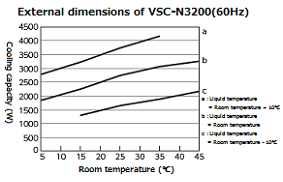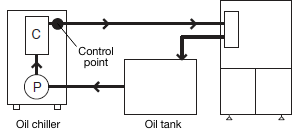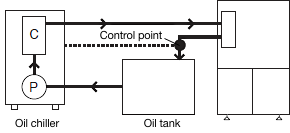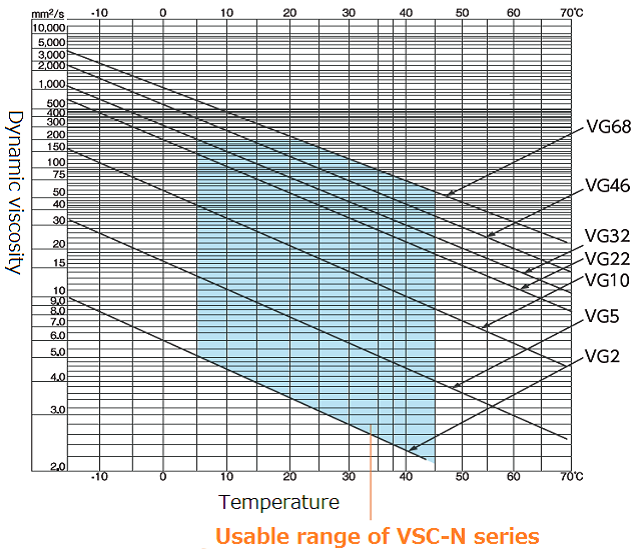Choosing an oil chiller
Those who are considering product introduction
![]()
Please feel free to contact us for inquiries such as on-site confirmation of product introduction, product details and prices.
How to select a model in the oil chiller
1. Method for selecting the oil chiller model
Selection flow
A - Checking the cooling capacity
① Determine the method of setting the target values.
The target values (SV) of oil chillers can be set by an absolute value method in which the desired value is input, or by a method that inputs the value from an external temperature sensor.
SV = Absolute value (set to 35 ℃ on the diagram below)

Set between 5 ℃ and 50 ℃
SV = Machine body temperature synchronization (external temperature input)

Oil chiller
The set temperature is synchronized with the temperature measured at X and changes in real time. The measured temperature can be controlled between -9.9 and +9.9 ℃.
SV = Room temperature synchronization (external temperature input)

Oil chiller
The set temperature is synchronized with the temperature measured at X and changes in real time. The measured temperature can be controlled between -9.9 and +9.9 ℃.
② Check the maximum temperature in the usage environment.
Air-cooling oil chiller cooling performance will vary depending on surrounding temperature.
The higher the surrounding temperature, the lower the cooling capacity, so check the maximum temperature in the usage environment.
③ Determine the minimum target temperature.
Determine the target oil temperature. When using the external temperature sensor input method, check the minimum expected temperature.
④ Check the oil chiller's cooling capacity.

The oil chiller's cooling capacity varies according to the temperature in the usage environment, the target oil temperature and the power supply frequency.
The graph indicating this variation character is called the “cooling capacity properties graph”, and can be found in the specifications.
Example) ① Target setting: (a) Absolute value control, ② Maximum temperature in usage environment: 30 ℃, ③ Minimum target temperature: 20 ℃ or greater. The graph on the right shows that under these conditions, the cooling capacity of the VSC-N3200 (60 Hz) is approximately 1700 W.
B - Determining the control point
The oil chiller's control point (PV) can be selected among the oil chiller's exit oil temperature or the oil temperature at any other position (external temperature input).
PV = Exit temperature

PV = External temperature input (device-side oil exit pipe)

C - Checking whether the oil can be used
① Check whether the oil to be used fulfills the oil chiller's specifications.
Use oil that meets all the conditions below in the oil chiller.
- ① Lubricating oil or hydraulic oil (mineral oil)
- ② Type 3 or 4 oil among the Type 4 hazardous substances defined in the Fire Services Act
- ③ Oils corresponding to color change number 1 in JIS K 2513, Petroleum Products - Corrosiveness To Copper - Strip Test
- ④ Kinematic viscosity of 1.4 to 200(ISO VG2 to 68) mm²/s
* Even oils meeting all of the conditions above may affect the product if they have deteriorated. We recommend performing periodic maintenance of the oil.
The viscosity of oils changes according to the temperature. Use the graph below to check whether the oil you want to use fulfills the above specifications.

The above graph shows the performance characteristics of typically used oils. There may be slight variations depending on the manufacturer and type of oil. For details, refer to information provided by the manufacturer of the oil you use.
② Correct the cooling capacity.
The oil chiller's cooling capacity properties graph indicates the properties when using ISO VG5 oil.
The cooling capacity calculated in “B” can be used as such when using ISO VG5.
When using ISO VG32, the viscosity of the oil is higher than ISO VG5, so the cooling efficiency is lower.
Because of this, the cooling capacity when using ISO VG32 is about 90% the value calculated in “B”.
Example) ① From the formula below, we see that the correction value for the cooling capacity calculated in “B” when using ISO VG32 is approximately 1728 W.
1920×0.9=1728 [W]
Check that the cooling capacity found in A to C above is higher than the load heat capacity of the device to be used.
* The cooling capacity and heat capacity differ according to the usage environment, the conditions of the oil being used and the device's operating conditions. We recommend performing a test when deciding on the model to check in advance that the oil chiller's cooling capacity is higher than the load heat capacity.
We're here to give you quick answers to your questions.
